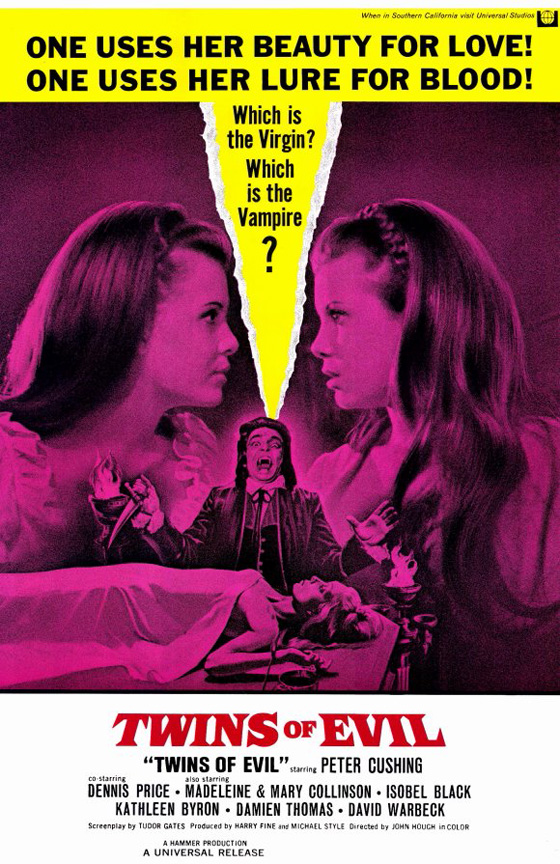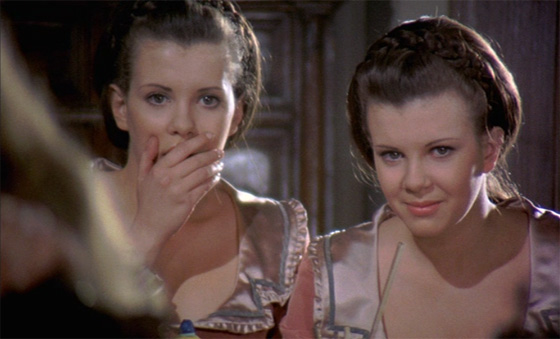
Long unavailable on DVD in the United States, Twins of Evil (1971) was finally released in July as part of Synapse’s fledgling “Hammer Horror Collection” of Blu-Ray/DVD combos (joining their earlier, welcome release of Vampire Circus). Directed by John Hough, who would go on to helm the genre touchstones The Legend of Hell House (1973) and Dirty Mary Crazy Larry (1974), the film is notably the third installment of Hammer’s “Karnstein Trilogy,” films inspired by Sheridan le Fanu’s Carmilla and an attempt to launch a new franchise for the studio, one both fleshier and bloodier than those which came before. Most fans consider Twins of Evil the crowning achievement of the series, and though, alas, it lacks The Vampire Lovers‘ fanged diva, Ingrid Pitt, it compensates with the wonders of the Collinson Twins, Mary and Madeleine, Maltese beauties who caught the eye of the producers somewhere between their Playboy spread and their Tonight Show appearance. In the spirit of true exploitation filmmaking, the girls were given starring roles (albeit with voices dubbed) alongside Hammer icon Peter Cushing. The result is a minor classic of Gothic horror filmmaking, unfolding like a sensual Grimm’s fable.
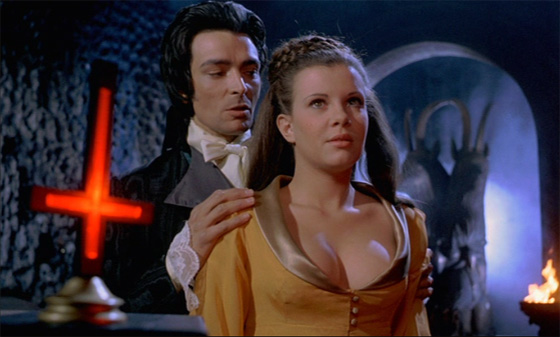
Count Karnstein (Damien Thomas) initiates Frieda (Madeleine Collinson) into the ways of evil.
Cushing, in one of his most compelling roles, plays Gustav Weil, a religious zealot who has convinced his “Brotherhood” of followers that the village of Karnstein and its surrounding woods are overrun with witches and vampires. They round up seemingly every unguarded young woman and burn her at the stake. At home, he tends to a patient wife, played by the terrific Kathleen Byron of Black Narcissus (1947), and his visiting twin nieces, the newly-orphaned Frieda (Madeleine Collinson) and Maria (Mary Collinson). While Maria is virtuous and innocent, Frieda is a hell-raiser who catches the attention of Anton (David Warbeck, Trog), seemingly the only man in the village who can tell them apart. But Frieda’s restlessness eventually leads her to the castle of Count Karnstein (Damien Thomas, Sinbad and the Eye of the Tiger), a Satanist who’s just resurrected the evil vampiress Mircalla (Katya Wyeth, replacing Pitt) and become a vampire himself. (Hough cleverly uses the twins for one inexpensive special effect: when Karnstein stands with Frieda before a mirror, demonstrating he has no reflection, it’s Mary Collinson who’s playing Madeleine’s reflection. The old Harpo Marx gag!) Karnstein bites Frieda – and, miles away, Maria feels the sting in her neck.
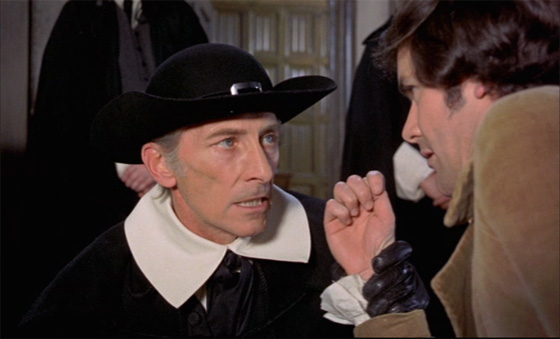
Anton (David Warbeck) fails to convince the fascistic Gustav (Peter Cushing) that he's killing innocents.
While Maria remains in bed at nights, pretending to be Frieda to protect her sister from punishment, the vampire Frieda roams the woods looking for victims. Catching her in the act, Gustav is horrified to discover that a member of his own family is now doing the work of the Devil. But it’s Maria he ties to the stake, and nearly burns to death before Anton catches the switcheroo. Only now does Gustav realize the danger of the lynch mob he’s created. (Cushing, who was devastated by the recent death of his wife Helen, has visibly aged in Twins of Evil; his haunted, intense stare only deepens the impact of his performance.) Anton, once the skeptic of all things supernatural, has a change of mind of his own when his beloved Frieda tries to tear out his throat with her teeth. Once opposed, Gustav and Anton now join forces to storm Karnstein’s fortress and destroy the Count and his mistress. Among the delights of the climax: a Gothic castle with flowing mist, thick cobwebs, and Suspiria-style blues, reds, and greens lighting the catacombs, as well as one of the most spectacular decapitations in Hammer’s history.
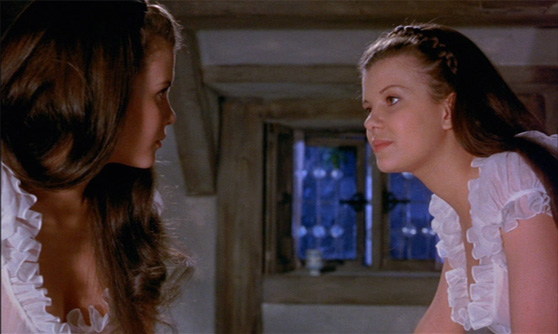
Mary and Madeleine Collinson as Maria and Frieda Gellhorn. The film's promotional materials asked, "Which is the Virgin? Which is the Vampire?"
Tudor Gates’ screenplay is a bit lumpy in its first half – bodies are turning up with vampire bites even before Mircalla is reincarnated, which suggests that another vampire story is unfolding somewhere (maybe the Vampire Circus is performing down the road?); and when Mircalla does arrive, she departs just as quickly. To that latter point, it’s been proposed that this is a prequel to The Vampire Lovers, not a sequel, an explanation which works well enough for me. But the film moves so swiftly that you only really think about its plot holes upon a second viewing. Synapse’s Blu-Ray/DVD package contains an array of respectful supplements, including an exhaustive feature-length documentary that covers Carmilla, its various film adaptations (including the underrated Blood and Roses), and Twins of Evil‘s production; there’s more, including a deleted scene with an anachronistic folk-music number that would have given the viewers whiplash (shades of Lust for a Vampire‘s “Strange Love”), plus a short survey of Hammer props, a gallery of production stills, and more. I’ll continue to revisit Twins of Evil every couple of years for Cushing’s extraordinary performance, the charms of the Collinsons, and Hough’s punchy direction, but it’s the complete package which provides such lasting appeal. This is 70’s Hammer at its pulpiest and most satisfying.
